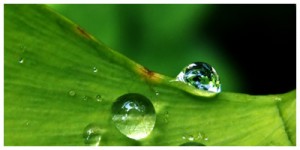Literally bubbling with the element water, the evening of June 18, 2013 at the Grand Théâre de Luxembourg offers a cooling refuge from the heat and humidity of that night. Flood is the latest choreography of Finnish-born Anu Sistonen, who has been playing an active role in the choreography scene of Luxembourg for several years now, and it explores the meaning of and associations with water. Unlike most of the earlier dance performances of season 2012/2013, this one has an intermission, which simultaneously marks the choreography’s division into two parts, Against the flow and Gives life/Takes life.
The first part, Against the flow, is musically accompanied by Polish pianist Beata Szalwinska’s live performance of Chopin’s Piano Sonata No. 3 in B-minor, at a glossy black grand piano set apart from the back of the stage with three long crinkled drapes lit in purple (Lighting: Jean Brücher). The choreography is beautifully interpreted by three dancers, whose fluid movements illustrate the movements of and with water itself. Clearly, the focus is on the female dancer, Jonna Aaltonen, whose graceful body and facial expressiveness is only complemented by the two male dancers, Grégory Beaumont and Ville Oinonen. In this part of the choreography, one of the two male dancers is continuously acting as an obstacle which the other two dancers are trying to overcome. The movements are dominated by jumps, turns and pirouettes, as well as smooth movements in which the dancers are gliding across the floor, or along the partner’s body, creating an image of the fluidity of water at one time, and that of the sheer force of moving water at other times. It is especially remarkable to see the dancers moving as if in slow-motion, depicting even more visibly the power of water.
Delving into the visuality of the element of water, the second and longer part of the choreography, Gives life/Takes life, is reinforced by a stage design with the same drapes of the first part, lit in varying colors, and a video projected on a giant sphere seemingly floating above face level at the center of the stage (Video: Miikka Heinonen), and large glass jars filled with water and aligned at the foreground of the stage. In fact, the changing graphics and video creations offer a cool backdrop against the vivid movements of the dancers, now five in total – the three dancers of the first part and another female dancer, Jennifer Gohier, as well as another male dancer, Julien Ficely – and dressed in classy garments made from shiny fabrics in scintillating colors that are evocative of the ocean and the deep sea (Costumes: Peggy Wurth). This scene is further enhanced by alternating sounds of rushing water and the roar of the surf, and electronic music with strong beats (Music: Emre Sevindik, feat. Benoît Legot). The theme of water of this part of the choreography is thus not only audible, but also very tangible to the audience: “water as a source of life and death, water as an element essential to our daily lives, water that gives us sensations and emotions, and water as movement.” Here, the dancers dance in interchanging pairs, only to break free again and continue on their own, in their own rhythm and time, and sometimes in a solo amidst the steady movements of the other dancers. Their body language is both soft and expressive, yet also impulsive, and bears isolated movements. Through dance lifts of great body tension, demonstrative formations on the floor, slow and silent movements fraught with expressiveness, thus, Anu Sistonen’s choreography is creating beautiful and emotional images, stirring up powerful notions of the meaning of water in life.
Johanna Wolter
Pictures © Miika Heinonen


